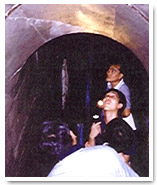Jump to the beginning of content
Supply and Distribution
Water Mains Replacement
Inside the inspection gallery of Lau Shui Heung Reservoir main dam
Plans for the replacement of Hong Kong's underground water mains were taken a step further with the study carried out during the year on the second phase of work to be done.
In the initial phase of the work proposed in a study completed in July 1997, some 350 kilometres of mains, out of some 3 050 kilometres earmarked for replacement, will be replaced over a period of seven years, as from 2000. Including sea water mains, the entire underground supply network amounts to some 6 250 kilometres.
A preliminary feasibility study on the project is being undertaken for final approval by the Works Bureau.
Meanwhile, guidelines have been prepared for the management of the surface assets, and a detailed methodology is being developed by consultants.
Slope Safety
A consultancy agreement has been reached for the development of a computerised database management system - known as the WSD Slope Management System (WSD SMS) - for the registered slopes under the Department's care.
Some 6,100 slopes are now being maintained, including more than 5 000 that have been assigned to it under the Systematic Identification of Maintenance Responsibility of Registered Slopes up to March 1999.
All slope inventory records, inspection results and maintenance records are expected to be stored in the system by November 1999.
During the year, Engineer Inspections for Maintenance (EIM) were completed on 513 slopes, Routine Maintenance Inspections (RMI) were carried out on some 2 100 slopes, and Routine Maintenance Work (RMW) done on 676. Sign plates were placed on 312 slopes.
A consultancy study has also been arranged for EIM on 500 slopes, over a period of eight months as from February 1999.
Meanwhile, full inspections were completed on ten priority catch-water areas, totalling some 50 kilometres.
Research and Development
Studies were carried out on the rehabilitation technology of old water mains for the purpose of improving their condition.
Two site trials on rehabilitation systems were conducted and the results are being studied for possible adoption in the Hong Kong environment. With the aim of further improving efficiency and productivity, a study was undertaken on selected outdoor works in connection with supply and distribution.
Reservoir Safety
During the year, some 1,190 safety inspections were carried out by consultants on impounding and service reservoirs. Under a new consultancy agreement, safety inspections are also being carried out on smaller reservoirs with a capacity below 25,000 cubic metres.
Maintenance Works
To improve the quality of maintenance works, a system of pre-qualification will be introduced for new term contracts. Careful monitoring and assessments will continue to be carried out on the conditions of mains so as to determine the need for replacement where necessary.
In the effort also to educate contractors on proper work practices to avoid damage to water mains, new publicity materials, in the form of posters, a pictorial booklet, and revised guidelines for excavations near water mains are being prepared for distribution.
At the same time the manpower needs for roadwork inspection teams will be kept in constant review to deal with the ever-increasing amount of roadwork that is going on.
Legislative Amendments
Work is continuing on proposed amendments to the Waterworks Regulations - one dealing with the transfer of the electrical requirements for unvented water heaters from the Waterworks Regulations to the Electrical Products (Safety) Regulations, and the other for the relaxation of the minimum flushing volume for flushing cisterns from 9 litres to 7.5 litres.
Enforcement
In the effective enforcement of the relevant legislation, some 240 prosecutions were carried out, resulting in fines totalling $440,200.
Organisation
The operational functions of the Supply and Distribution Branch are performed on a structure that comprises five regions - Hong Kong and Islands, and Mainland North East, North West, South West and South East.
A Regional Administration Division, functioning under the Branch, is responsible for co-ordinating functions and matters requiring centralised operation, including leakage detection, reservoir safety inspection and prosecution enforcement.
The Hong Kong and Islands Region, together with the Regional Administration Division and the Water Science Division are under an Assistant Director, and the four Mainland regions are under another.
Monitoring Quality
The Water Science Division is responsible for continuously monitoring the quality of water throughout the entire water supply system by carrying out physical, chemical, bacteriological, biological and radiological examinations of water samples. Some 150 260 samples were taken for tests during 1998/99.
Leak Detection
Leakage of water from mains is a perennial - and universal problem. In Hong Kong continuous attention is devoted to detecting leaks in the supply and distribution systems, and, particularly, in preventing leaks from developing into mains bursts.
Trial pressure management schemes based on the latest consultants' reports, are being carried out to optimise the operating pressure of supply networks and will be introduced on a larger scale if successful.
In connection with the safety of slopes with buried water mains, a two-year works contract was awarded, and a further contract for such work was being prepared for work to start in September 1999.
Meter Replacement
Meanwhile, work has been stepped up in the replacement of the older water meters in conjunction with the replacement of internal water pipes by the Housing Department in public housing estates as well as in private developments.
Service Reservoir Cleaning
Some new works undertaken during the year included an improved method of cleaning service reservoirs by using high pressure water jets. All effluent produced is fully treated to remove suspended solids and chlorine before discharge to surface drainage.
Supply and Distribution
